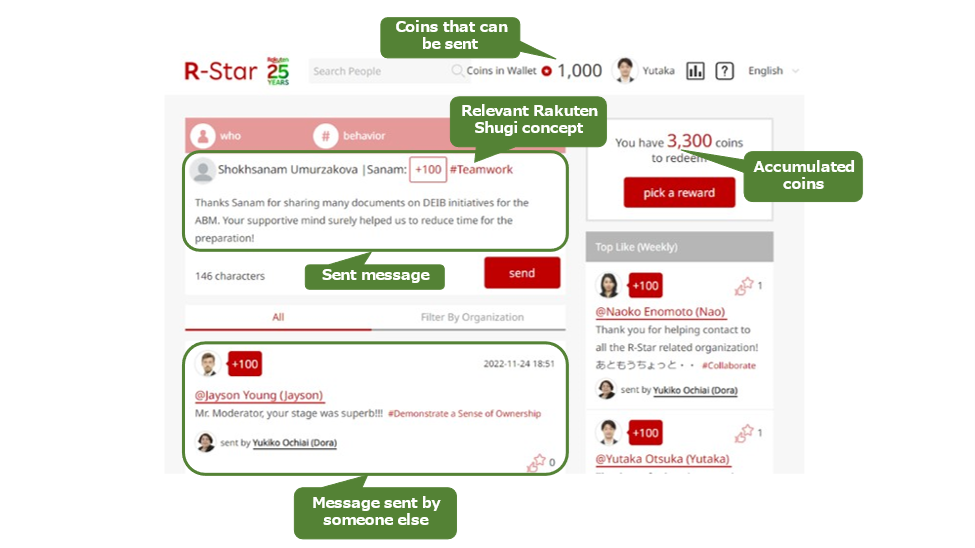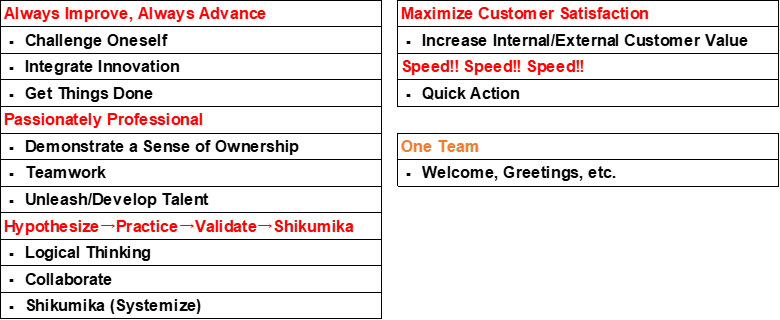As the frequency with which people are going to the office has shifted amid the prevalence of hybrid work for some companies or jobs, have you noticed a decrease in opportunities to meet and talk to your colleagues in person? And at the same time, have you noticed a decrease in opportunities to convey gratitude to your colleagues?
In the previous column, we highlighted the positive impact that gratitude can have on individuals who express their appreciation as well as on the well-being of the organization.
In this column, we will present a mechanism for intentionally and proactively enjoying the benefits of gratitude even under hybrid work arrangements, focusing on the Rakuten Group as an example.
Communicating gratitude within an organization
One way to communicate gratitude within an organization is through recognition. To “recognize” someone can mean more than simply recognizing who they are; it can also mean to properly evaluate or acknowledge their achievements, as well as expressing words of appreciation or gratitude.
One classification of terms related to human resource systems that reward contributions made to the organization refers to non-monetary praise or recognition rather than direct monetary rewards such as special bonuses. Additionally, “social recognition” refers to an approach in which peers praise and acknowledge one another within the organization.
Currently, companies both in Japan and overseas offer such social recognition platforms as web-based services to various companies.
Examples of social recognition in practice in the Rakuten Group
The Rakuten Group developed its own social recognition platform called R-Star. Following a trial introduction and operation among a select number of departments, a larger-scale rollout across various departments is now underway.
Along with messages of appreciation, R-Star allows employees to send coins as points to colleagues. Once a certain number of coins has been collected, they can be exchanged for Rakuten Points, which can be used for a variety of Rakuten Group services, including shopping, travel, investments, insurance, and mobile phones.
In addition, when sending a thank-you message, the person who sends it selects which concept of Rakuten Shugi, the Rakuten Group’s corporate philosophy, that the recipient’s actions was related to. The system is intended to boost awareness of Rakuten Shugi and encourage employees to think about this philosophy in their day-to-day actions.
Thank-you messages can also be viewed by other members of the company, allowing them to see the work of other employees and the contributions they are making. In addition, they can see who their colleagues have working relationships with, which makes it possible for them to connect with those people through their colleagues.


Effectively applying social recognition
Based on our experience with the R-Star system at Rakuten, we believe there are four important points to be aware of when expressing gratitude by means of social recognition.
1)Creating an atmosphere
2)Making gratitude a habit
3)Effective methods of sending thanks
4)Points to be aware of when receiving thanks
Using examples from the R-Star system, we would like to share some tips on how to promote the use of social recognition and how to increase or maintain the frequency of use when introducing the system.
1)Creating an atmosphere
The active involvement of managers
First of all, when introducing a social recognition system into an organization and attempting to make it take root, it is important for managers to take the initiative. Specifically, immediately after the system has been introduced, managers should be the first to send messages to the members of their workplace.
By being proactive in expressing their gratitude, upper-level managers can create an atmosphere within the organization demonstrating that expressing gratitude is not difficult to do, and that managers welcome the introduction of such a tool.
When R-Star went online, managers were encouraged to actively use it in an effort to increase user numbers. In addition, at regular team meetings and other gatherings, managers introduced select portions of the recognition messages that were sent among members, which proved to be an effective means of conveying that sending messages of gratitude to one another is important and meaningful to the organization, fostering a culture of sharing mutual recognition.
2)Making gratitude a habit
Even after a social recognition system has been introduced, making social recognition a habit can be a challenge. Some people may not be used to expressing thanks and may wonder what they should be thankful for.
Link it to events
One way to raise awareness of gratitude while also lowering the hurdle of making gratitude a habit is to create a system for conveying gratitude by connecting it to some kind of event.
Taking the Rakuten Group as an example, when managers were encouraged to use the theme “Expressing gratitude for the year” at the end of the year, there was a significant increase in usage. Other opportunities for recognition that could be used to boost expressions of gratitude include connecting it to various occasions, such as company anniversaries and employee work anniversaries.
Focus on “behind-the-scenes contributors”
Many companies have awards programs designed to acknowledge employees who have achieved major accomplishments. But instead of focusing additional recognition on such individuals, in order to foster a corporate culture in which members across the entire organization are able to express appreciation to one another, it may be more important to leverage recognition as an opportunity to shine the spotlight on those whose contributions behind the scenes made possible the successes of others.
3)Effective methods of sending thanks
Send it promptly
Due to the busy nature of our work, it’s easy to put off expressing gratitude till later. But this can result in inadvertently forgetting to do so, leading to a decrease in the overall number of times that appreciation is conveyed. Additionally, over time, the person sending the thanks and the person receiving it will gradually forget what it was that was deserving of thanks in the first place.
Furthermore, according to Achievers Solutions, a social recognition services provider, giving recognition in real time makes it more likely that those who were recognized for a specific action will take that action again in the future, and what gets recognized gets repeated.1
Be specific
According to Fond, another social recognition services provider, specific praise lets employees know exactly what actions and skills they succeeded at. So, instead of a generic message like “Great job!” providing a colleague with a custom note that calls attention to specific aspects of the work they did well will make them feel truly recognized and encourage similar behavior in the future.2
Therefore, rather than simply saying, “Thank you for [the job in question],” specify what it was about the job they did that you felt was worthy of recognition, such as the speed of the work they did, the various knowledge and skills that they brought to the task, the proactive attitude they displayed, the kindness they showed you by taking time out of their busy schedule, or how much their assistance helped you and others.
It appears that such prompt and specific expressions of gratitude serve to make the other person aware of the types of behavior and attitude that are desirable for his or her colleagues and team, and this, in turn, lays the groundwork for the next good action. In addition, the person receiving the thanks will likely view the appreciation being expressed as genuine, based on a thorough understanding of his or her own actions and behavior. And unlike when relying on superficial or perfunctory praise, granting recognition in this way may serve toward the strengthening of a relationship based on familiarity and trust with the other person.
4)Points to be aware of when receiving thanks
Don’t set your expectations for appreciation too high
According to Ito (2014, p. 944), people who expect and strongly desire to be thanked have a tendency toward anger. Accordingly, it’s probably a good idea to temper your expectations and not think that with the installment of a social recognition system, you will be thanked by many of the people you work with.
But if the introduction of a social recognition system causes some employees to feel angry, then it could result in lowering well-being on an individual basis as well as for the organization.
In this column, we introduced the social recognition platform employed at Rakuten along with several key points that need to be kept in mind when using such a system to share expressions of gratitude.
Under current working conditions, such as hybrid work, which for many has resulted in fewer opportunities to meet and talk to colleagues in person, it may be to your organization’s advantage to effectively apply this type of social recognition system. In addition to increasing opportunities for communication with colleagues, it could also help boost well-being for both individuals and the organization alike.
1:Achievers「Social Recognition: What, Why, and How」 (Referenced on November 24, 2022).
2:FOND「THE INSIDER’S GUIDE TO PEER-TO-PEER RECOGNITION」 (Referenced on November 24, 2022).
Work cited:
Ito, T. (2014). The relationships among experience of being appreciated, frequency of emotion experience, and achievement motivation. The Proceedings of the 78th Annual Convention of the Japanese Psychological Association, 944.

